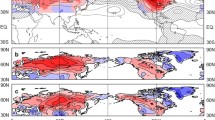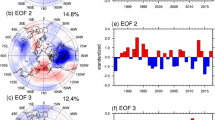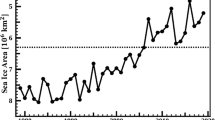Abstract
This study deals with the correlation between ice extent in the Sea of Okhotsk and the interannual variability of winter (December–February) air temperature over the subtropical Western Pacific from 1979 to 2008. The analysis indicates that the increase in sea ice extent coincides not only with cooling over the Sea of Okhotsk and the adjacent area, but also with significant warming over the subtropical Western Pacific that extends from the surface to the middle troposphere. This meridional dipole pattern of tropospheric temperature anomalies (cooling in the high latitudes and warming in the low latitudes) primarily results from dynamical processes driven by the large-scale atmospheric circulation change. A heat budget diagnosis reveals that when ice extent in the Sea of Okhotsk increases by one standard deviation, the tropospheric air temperature over the subtropical Western Pacific rises by about 0.25°C. It also suggests that the adiabatic heating and stationary eddy heat flux convergence may be the most important factors, which account for 30 and 15% of the warming, respectively. In addition, these two factors also coordinate to result in significant cooling over the Sea of Okhotsk and the adjacent regions.












Similar content being viewed by others
References
Ambaum MHP, Hoskins BJ, Stephenson DB (2001) Arctic Oscillation or North Atlantic Oscillation? J Clim 14:3495–3507
Armstrong AE, Tremblay LB, Mysak LA (2003) A data-model intercomparison study of Arctic sea-ice variability. Clim Dyn 20:465–476
Budikova D (2009) Role of Arctic sea ice in global atmospheric circulation: a review. Glob Planet Change 68:149–163
Chiang JCH, Bitz CM (2005) Influence of high latitude ice cover on the marine Intertropical Convergence Zone. Clim Dyn 25:477–496
Clark MP, Serreze MC (2000) Effects of variations in East Asian snow cover on modulating atmospheric circulation over the North Pacific Ocean. J Clim 13:3700–3710
Fang Z, Wallace JM (1994) Arctic sea ice variability on a timescale of weeks and its relation to atmospheric forcing. J Clim 7:1897–1914
Gong D-Y, Ho C-H (2002) The Siberian High and climate change over middle to high latitude Asia. Theor Appl Climatol 72:1–9
Gong D-Y, Wang S-W, Zhu J-H (2001) East Asian winter monsoon and Arctic oscillation. Geophys Res Lett 28(10):2073–2076
Honda M, Yamazaki K, Nakamura H, Takeuchi K (1999) Dynamic and thermodynamic characteristics of atmospheric response to anomalous sea-ice extent in the Sea of Okhotsk. J Clim 12:3347–3358
Kalney E et al (1996) The NCEP/NCAR 40-year reanalysis project. Bull Am Meteor Soc 77:437–471
Lau N-C, Nath MJ (2000) Impact of ENSO on the variability of the Asian–Australian Monsoons as simulated in GCM experiments. J Clim 13:4287–4309
Liu J, Zhang Z, Horton RM, Wang C, Ren X (2007) Variability of North Pacific sea ice and East Asia–North Pacific winter climate. J Clim 20:1991–2001
Parkinson CL (1990) The impact of the Siberian high and Aleutian low on the sea-ice cover of the Sea of Okhotsk. Ann Glaciol 14:226–229
Parkinson CL, Rind D, Healy RJ, Martinson DG (2001) The impact of sea ice concentration accuracies on climate model simulations with the GISS GCM. J Clim 14:2606–2623
Raymo ME, Rind D, Ruddiman WF (1990) Climatic effects of reduced Arctic sea ice limits in the GISS II general circulation model. Paleoceanography 5:367–382
Rayner NA, Parker DE, Horton EB, Folland CK, Alexander LV, Rowell DP, Kent EC, Kaplan A (2003) Global analyses of sea surface temperature, sea ice, and night marine air temperature since the late nineteenth century. J Geophys Res 108(D14):4407. doi:10.1029/2002JD002670
Rodionov SN, Overland JE, Bond NA (2005) The Aleutian Low and winter climatic conditions in the Bering Sea. Part I: classification. J Clim 18:160–177
Royer JF, Planton S, Deque M (1990) A sensitivity experiment for the removal of Arctic sea ice with the French spectral general circulation model. Clim Dyn 5:1–17
Sasaki YN, Katagiri Y, Minobe S, Rigor IG (2007) Autumn atmospheric preconditioning for interannual variability of wintertime sea-ice in the Okhotsk Sea. J Oceanogr 63:255–265
Walsh JE (1995) A sea ice database. In: Folland C, Rowell D (eds) Workshop on simulations of the climate of the twentieth century using GISST, 28–30 November 1994. Hadley Centre for Climate Prediction and Research CRTN 56, pp 54–58
Wang J, Ikeda M (2000) Arctic oscillation and Arctic sea-ice oscillation. Geophys Res Lett 27(9):1287–1290
Wang C, Weisberg RH, Virmani JI (1999) Western Pacific interannual variability associated with the El Niño–Southern Oscillation. J Geophys Res 104:5131–5149
Wang B, Wu R, Fu X (2000) Pacific-East Asian teleconnection: how does ENSO affect East Asian climate? J Clim 13:1517–1536
Wang J, Jin M, Musgrave D, Ikeda M (2004) A numerical hydrological digital elevation model for freshwater discharge into the Gulf of Alaska. J Geophys Res 109:C07009. doi:10.1029/2002JC001430
Wang B, Wu Z, Chang C-P, Liu J, Li J, Zhou T (2010a) Another look at interannual-to-interdecadal variations of the East Asian Winter Monsoon: the northern and southern temperature modes. J Clim 23:1495–1512
Wang J, Bai X, Wang D-X, Hu H, Yang X-Y (2010b) Interannual variability of the East Asia winter monsoon, as controlled by the Siberian High and Arctic Oscillation: driving downwelling in the western Bering Sea. Submitted to Aquat Ecosyst Health Manag
Wu B, Wang J (2002) Winter Arctic Oscillation, Siberian High and the East Asia winter monsoon. Geophys Res Lett 29(19):1897–1900
Acknowledgments
We thank three reviewers for their insightful suggestions and comments. This study is supported by the NSFC under contract of 41006113 and 40821063, by the National Basic Research Program of China (2007CB411803), and by MELRS0920 of Xiamen University (for Yang and Hu). Wang is supported by the RUSALCA modeling project of NOAA Office of Arctic Research.
Author information
Authors and Affiliations
Corresponding author
Rights and permissions
About this article
Cite this article
Yang, XY., Hu, J., Wang, J. et al. Linkage between winter air temperature over the subtropical Western Pacific and the ice extent anomaly in the Sea of Okhotsk. J Oceanogr 67, 197–208 (2011). https://doi.org/10.1007/s10872-011-0018-3
Received:
Revised:
Accepted:
Published:
Issue Date:
DOI: https://doi.org/10.1007/s10872-011-0018-3




